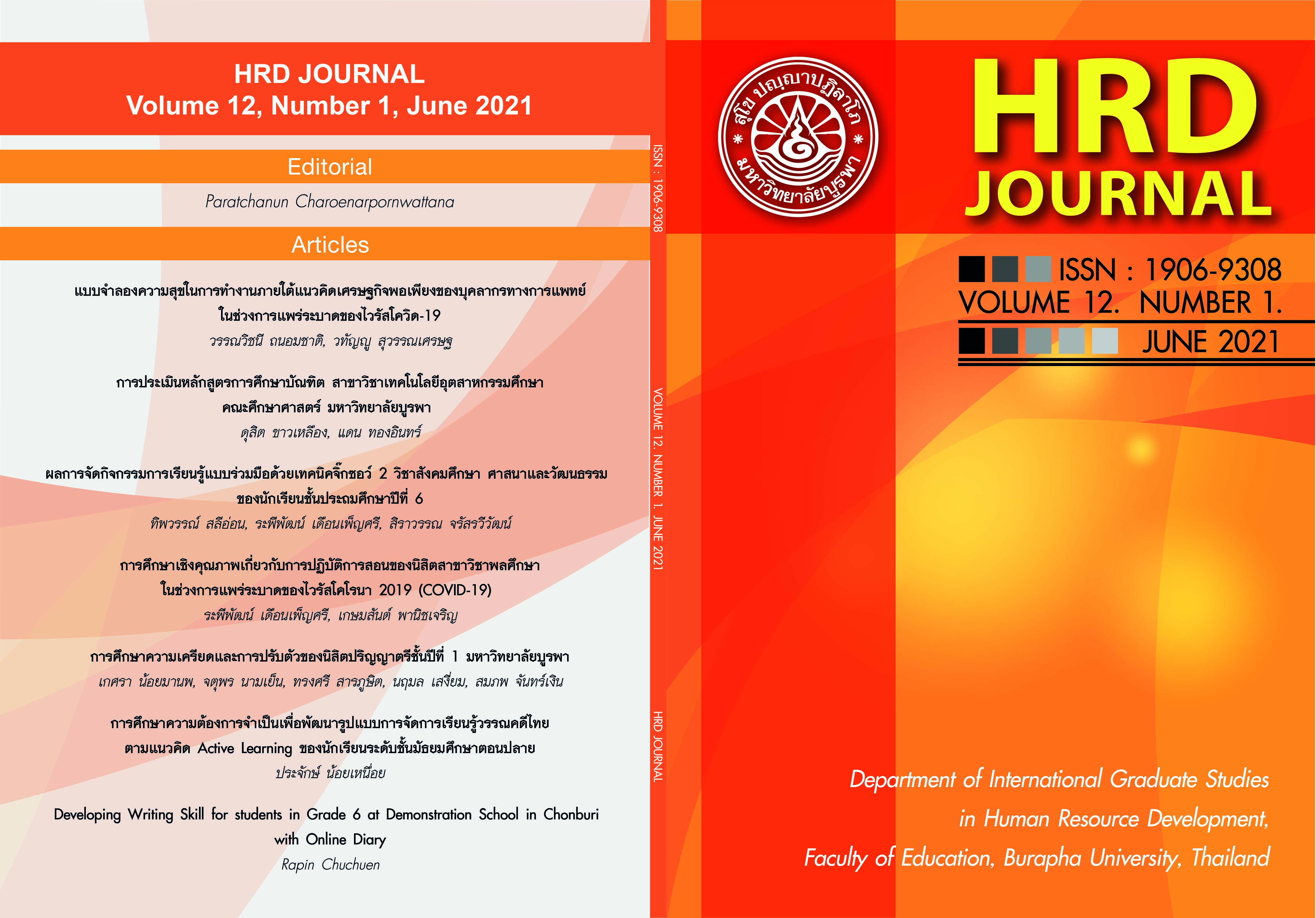A Model of Working Happiness under the Concept of Sufficiency Economy of the Healthcare Professionals during the Covid-19 Pandemic
Keywords:
Working happiness, The concept of the sufficiency economy, Healthcare professionals COVID-19Abstract
The purposes of this study were 1. to survey the level of working happiness under the concept of the sufficiency economy of the healthcare professionals during the COVID-19 Pandemic, 2. to develop and confirm the model of working happiness under the concept of the sufficiency economy of the healthcare professionals during the COVID-19 Pandemic. To review the structures of each variable and avoid being inaccurate in presenting the structural equation model, a confirmatory factor analysis (CFA) was run. The data collection instrument in this study was a developed close-ended questionnaire which was constructed based on the concepts of the Happy Workplace introduced by Thai Health Promotion Foundation and the concept of the Sufficiency Economy that His Majesty King Bhumibol Adulyadej gave the initiative to guide the way of life for the Thai people. Data was collected with 318 healthcare professionals working in hospitals in Bangkok. This study found that the levels of all the eight working happiness components under the concept of the sufficiency economy of the healthcare professionals working in hospitals in Bangkok during the COVID-19 Pandemic were reported at high levels. The highest working happiness component was ‘Happy Family’
( = 3.56 and S.D. = 0.56) and the lowest one was ‘Happy Body’ (
= 3.44 and S.D. = 0.56). The result of confirmatory factor analysis of the structural equation model was a good fit with the empirical data which well explained all the working happiness components of the healthcare professionals working in hospitals in Bangkok during the COVID-19 Pandemic
(x2/df = 1.19, GFI = 0.95, AGFI = 0.92, CFI = 0.99, RMSEA = 0.02, NFI = 0.95). Considering the Factor Loading of working happiness components in the model, all factors were found significantly positive (P<0.001). The largest Factor Loading was ‘Happy Brain’. When looking at the coefficient of determination, the responsibility at work (R2 = 0.62) showed the highest score among the other variables and healthcare professionals' responsibility at work could, up to 62 percent, explain that the responsibility at work was the happiness encouraging the healthcare professional to enjoy their new discoveries. Although ‘Happy Body’ was the component that had the smallest factor loading among all the variables, Factor Loadings of all the eight working happiness components were positively found between 0.75 and 0.89. The way of life (R2 = 0.8) was the variable which could by a factor of 80 percent explain ‘happy body’.
References
กระทรวงสาธารณสุข. (2020). ประสบการณ์ของประเทศไทยในการจัดการกับโควิด-19 (ออนไลน์). สืบค้นจาก :
https://ddc.moph.go.th/viralpneumonia/eng/file/pub_doc/LDoc9.pdf [25 ธันวาคม 2563]
กรุงเทพธุรกิจ. (2563). ‘หมอ’ และ ‘พยาบาล’ รวมทั้งบุคลากรสาธารณสุขทำงานหนักแค่ไหนเพื่อสู้ โควิด-19 (ออนไลน์). สืบค้นจาก : https://www.bangkokbiznews.com/news/detail/874658 [25 ธันวาคม 2563]
กรมควบคุมโรค. (2563). โรคติดเชื้อไวรัสโคโรนา 2019 (COVID-19) (ออนไลน์). สืบค้นจาก : https://ddc.moph.go.th/viralpneumonia/faq_more.php [25 ธันวาคม 2563]
กรมสุขภาพจิต. (2563). กรมสุขภาพจิต จับมือ เสถียรธรรมสถานฟื้นฟูจิตใจบุคลากรทางการแพทย์ผู้ปฏิบัติงานในสถานการณ์โควิด-19 และประชาชนกลุ่มเสี่ยงสร้างต้นแบบพื้นที่กรุงเทพมหานคร (ออนไลน์). สืบค้นจาก : https://gnews.apps.go.th/news?news=62662 [25 ธันวาคม 2563]
ผู้จัดการออนไลน์. (2563). เบื้องหลังของด่านหน้า! “บุคลากรทางการแพทย์” ที่คุณอาจจะยังไม่รู้ (ออนไลน์). สืบค้นจาก : https://mgronline.com/onlinesection/detail/9630000048685 [25 ธันวาคม 2563]
มหาวิทยาลัยเกษตรศาสตร์. (2563). โควิด 19 และระบาดวิทยา: การสร้างขวัญและกำลังใจให้บุคลากรทางการแพทย์ (ออนไลน์). สืบค้นจาก : https://learningcovid.ku.ac.th/course/?c=8&l=4 [25 ธันวาคม 2563]
ยงยุทธ วงศ์ภิรมย์ศานติ์. (2563). การดำเนินงานสุขภาพจิตภายใต้วิกฤตโควิท 19 ของประเทศไทย. วารสารสุขภาพจิตแห่งประเทศไทย, 28(4), 280-291.
โรงพยาบาลจุฬารัตน์ 9 แอร์พอร์ต. (2563). COVID-19 ติดได้จากทางไหนบ้าง (ออนไลน์). สืบค้นจาก :
https://ch9airport.com/th/how-covid-19-contagion/ [25 ธันวาคม 2563]
ธุวนันท์ พานิชโยทัย, พิชฎา อารยานุรักษ์, อมรทิพย์ ภิรมย์บูรณ์, วารีรัตน์ ทองสม, เสาวรส หมอนวด, วิศรุต ตุ้ยศักดา. (2552). นวัตกรรม ภูมิปัญญาเศรษฐกิจพอเพียง องค์ความรู้ของเกษตรกรและชุมชน. กรุงเทพฯ: สถาบันสร้างเสริมนวัตกรรมภูมิปัญญาเศรษฐกิจพอเพียง กรมส่งเสริมการเกษตร.
วรรณวิชนี ถนอมชาติ และณฤดี พรหมสุวรรณ. (2562). A Confirmatory Factor Analysis of Factors Promoting a Happy Workplace in the Eastern Region of Thailand. วารสารการจัดการธุรกิจ มหาวิทยาลัยบูรพา, 8(1), 14-28.
วิศิษฎ์ เนติโรจนกุล. (2563). ความชุกและปัจจัยที่เกี่ยวข้องของปัญหาทางสุขภาพจิตของบุคลากรทางการแพทย์ โรงพยาบาลนครปฐมในยุคการระบาดของโรคติดเชื้อไวรัสโคโรนา 2019 (โควิด-19). วารสารแพทย์ เขต 4-5, 39(4), 616-627.
สำนักงานกองทุนสนับสนุนการสร้างเสริมสุขภาพ. (2552). คู่มือมาสร้างองค์กรแห่งความสุขกันเถอะ. กรุงเทพฯ
สำนักงานคณะกรรมการพัฒนาการเศรษฐกิจและสังคมแห่งชาติ. (2550). การประยุกต์ใช้ปรัชญาเศรษฐกิจพอเพียง. กรุงเทพฯ: คณะอนุกรรมการขับเคลื่อนเศรษฐกิจพอเพียง สำนักงานคณะกรรมการพัฒนาการเศรษฐกิจและสังคมแห่งชาติ.
นภัสจันท์ มงคลพันธ์, เธียรชัย งามทิพย์วัฒนา, สุชีรา ภัทรายุตวรรณ์ และวิชัย มนัสศิริวิทยา. (2560). ความสุขในการทำงานของบุคลากรโรงพยาบาลตติยภูมิ. วารสารศูนย์การศึกษาแพทยศาสตร์คลินิก โรงพยาบาลพระปกเกล้า, 34(2), 87-99.
Hair, J. F., Black, W. C., Babin, B. J., & Anderson, R. E. (2010). Multivariate Data Analysis (7th Ed.). New Jersey: Pearson Education.
Bentler, P.M., Chou, C.H. (1987). Practical issues in structural modeling. Sociological Methods & Research, 16, 78–117.
Burton, J. (2010). WHO Healthy Workplace Framework and Model: Background and Supporting Literature and Practices. WHO Headquarters, Geneva, Switzerland.
Law, T. (2020). We Carry That Burden.' Medical Workers Fighting COVID-19 Are Facing a Mental Health Crisis. Retrieved December 25, 2020, From Time Magazine: https://time.com/5817435/covid-19-mental-health-coronavirus/
Schumacker, R. E., & Lomax, R. G. (2016). A Beginner's Guide to Structural Equation Modeling (4th Ed.). New York: Routledge.
United States Department of Labor Bureau of Statistics. (2010). American Time Use Survey. วันที่ค้นข้อมูล 11 มกราคม 2564. เข้าถึงได้จาก http://www.bls.gov/news.release/atus.nr0.html
Downloads
Published
How to Cite
Issue
Section
License
Copyright@HRD Journal, Burapha University






